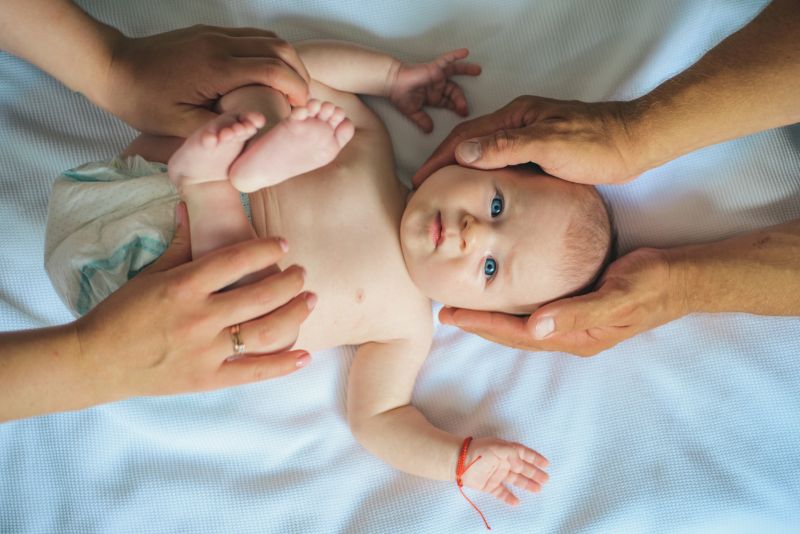
Torticollis Physical Therapy: Causes, Symptoms, and Torticollis Treatment
What is Torticollis?
Torticollis is an abnormal head and neck position and is common in infants. Usually presents as head tilted to one side with one ear closer to shoulder.
What Causes Torticollis?
Torticollis may be caused by tightness in the muscle on one side of the neck (this muscle is called the sternocleidomastoid).
There may be tightness in other neck or shoulder muscles as well.
What are the Signs of Torticollis?
Your baby will prefer to turn their head to one side and have difficulty turning their head to the opposite side. You may see this most when your baby is in a car seat or in photos.
Your baby may have a flattening or bulge on the back or side of the head. This is called plagiocephaly. You may notice one ear is forward of the other ear. Muscle tightness may also change the shape of your baby’s facial features on one side of the face. For example, their cheek may appear fuller on one side, or their eye may be “more open” in appearance compared to the other side.
Your baby may become fussy when you try to change the position of their head or when they are put on their tummy because they cannot lift or turn their head.
How is Torticollis Treated?
The affected muscle in your baby’s neck may be shortened and tight, while the muscles on the other side of the neck may be stretched and weak. Our goals are to help you position your baby in the midline, stretch the tight neck muscles and strengthen the weaker neck muscles.
Three main things influence good outcomes in babies with torticollis:
- How severe the torticollis is
- How old your baby is when you start treatment
- How well you follow through on your home exercise program.
What Can I Do for Torticollis Treatment?
There are four main areas that you can work on with your baby. They are:
- Positioning
- Stretching
- Strengthening
- Motor development
Positioning Exercises
Focus on positioning your baby’s head, neck, and trunk in a more neutral position while in a car seat or crib. Also, promote activities to help turn heads to their non-preferred side. Positioning tips
- Look at your baby’s head position throughout the day. Does your baby prefer to turn to their head right or left?
- Help your baby to keep their head in a straight line
As your baby gets older, they should spend as much time lying on their tummy. Use a Boppy type pillow, rolled towel, or foam wedge if it is still hard for your baby to lift their head. This helps them tolerate this position longer.
Stretching Exercises
Passive range of motion (gentle stretches) may help your baby achieve full neck motion. You can start doing these stretches right away.
Stretching tips
- Work gently within your baby’s tolerance. Slowly increase the motion over time.
- Find the position and time of day that works best for your baby.
- Hold these gentle stretches for about 30 seconds. Stop the stretch sooner if your baby starts to resist the motion or becomes fussy.
- You should never feel like you are forcing the motion.
- You can hold the stretch for up to 1 minute if your baby is very relaxed.
Strengthening Exercises
As your baby gains head control, you can begin to strengthen their weaker side neck muscles.
One way you can do this is to use a “head righting reaction.”
- This is when you place your baby in certain positions, so they use their muscles to lift their head against gravity. This strengthens the muscles and will also help with the head shape.
- Continue to encourage “tummy time” and crawling position as this helps promote head and trunk strength and stability.
Motor Development
As your baby grows, we want to help them develop a balance of strength and movement. We can use motor skills to help strengthen their neck muscles and encourage them to use both arms and legs equally, move to both sides and develop good motor patterns.
Motor skills include
- Visual tracking exercises
- Rolling exercises
- Crawling
Mobility
As your baby becomes mobile, they will crawl, pull to stand, and move from sitting to their stomach, side-lying to sit, and sit to stand. Watch how your baby shifts and encourage them to move to both sides. Use either leg to kneel or arm to reach for toys.
Once your baby appears to have normal head movement and position, you may still see their head tilt when they are tired, ill, teething, eating, or learning a new skill such as sitting, crawling, or walking.
Help Your Child with Torticollis Physical Therapy at Moriarty PT
The pediatric physical therapists at Moriarty PT are ready to assist your child with their torticollis physical therapy needs. Since we know that parenting life can be busy, we’ve made it easy to request an appointment online. We look forward to serving you!